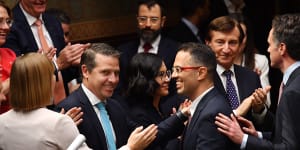is on brand for the Minns government. Just as it took a small-target approach to getting elected in March,Tuesday’s budget was risk-averse,unsurprising and helped along with a sprinkling of good luck. Or at least fortunate timing.

NSW Treasurer Daniel Mookhey received a tap on the back from Premier Chris Minns after delivering the budget.AAP
Rising revenues – thanks to soaring housing prices which will deliver a significant boost to stamp duty receipts and a strong labour market which will boost payroll tax – have helped Labor position itself to deliver a modest surplus next financial year.
After a five-year run of deep deficits in NSW – not ignoring the $7.8 billion recorded this financial year – a surplus,albeit very modest,allows Labor to claim fiscal responsibility.
This was important against the backdrop of wage rises for public sector workers. The budget papers show that government employee expenses (the largest component of the budget) are projected to grow,on average,by 4.1 per cent per annum.
The Coalition,despite Labor’s mandate to scrap the wages cap for frontline workers,will insist that the state’s finances cannot cope with such hefty pay increases. “This is a government that is delivering to union mates at the expense of families,” NSW Opposition Leader Mark Speakman said immediately after Treasurer Daniel Mookhey’s budget speech.
Regardless of the Coalition’s claims,this is not a big spending budget. There are no cash splashes.
Rather,the government has made cuts and trims to programs – including the popular family-friendly vouchers such as Active Kids and Back to School. This could have been a risky move during a cost-of-living crisis,except as luck would have it,the former government had not provided ongoing funding for those programs anyway.
The government has also been able to make cuts in the regions,which the Nationals would never have allowed when in coalition with the Liberals. The seniors travel card,a key election commitment from the Nationals in 2019,will be cut significantly,as will a card to help university students offset the cost of their travel in the regions.
Labor has also changed direction on other schemes,choosing to end a subsidy for drivers buying new electric vehicles and will instead redirect some of those savings into rolling out more charging stations in the regions and around apartment blocks. Without saying it quite so explicitly,Labor was no longer prepared to help those already wealthy enough to buy a Tesla.
There were other more technical measures used to improve the bottom line,including suspending contributions into the NSW Generations Fund and restructuring the scandal-ridden Transport Asset Holding Entity. “Significant decisions made towards budget repair”,is how Labor describes them.
Labor has prioritised and redirected spending,as you would expect a new government to do,and makes the point that it is keeping cash aside for a rainy day. But even Mookhey has acknowledged that its modest projected surplus next year remains a hope and not a certainty.
It will take continued good luck to land in the black next year.
Get the day’s breaking news,entertainment ideas and a long read to enjoy.